Page 504 - Mechanical Engineers' Handbook (Volume 4)
P. 504
4 Insulation Systems 493
Figure 27 T limitation for contaminant cleanup in a regenerator.
offer the same flow resistance and that the two phases are well distributed in the flow stream
approaching the distribution point. Streams that cool during passage through an exchanger
are likely to be modestly self-compensating in that the viscosity of a cold gas is lower than
that of a warmer gas. Thus, a stream that is relatively high in temperature (as would be the
case if that passage received more than its share of fluid) will have a greater flow resistance
than a cooler system, so flow will be reduced. The opposite effect occurs for streams being
warmed, so that these streams must be carefully balanced at the exchanger entrance.
4 INSULATION SYSTEMS
Successful cryogenic processing requires high-efficiency insulation. Sometimes this is a proc-
essing necessity, as in the Joule–Thomson liquefier, and sometimes it is primarily an eco-
nomic requirement, as in the storage and transportation of cryogens. For large-scale cryogenic
processes, especially those operating at liquid nitrogen temperatures and above, thick blan-
kets of fiber or powder insulation, air or N filled, have generally been used. For lower
2
temperatures and for smaller units, vacuum insulation has been enhanced by adding one or
many radiation shields, sometimes in the form of fibers or pellets, but often as reflective
metal barriers. The use of many radiation barriers in the form of metal-coated plastic sheets

